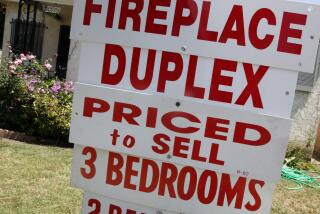With Bigger SBA Loans, Bigger Plans
Apparently, $2 million doesn’t go as far as it used to.
That’s the cap for the Small Business Administration’s most popular loan, and many lenders want to see it raised. Legislation to boost the limit to $3 million recently sailed through the Senate Small Business and Entrepreneurship Committee.
The 50% increase, which is contained in legislation to reauthorize SBA programs, would help the agency’s flagship loan keep pace with the increasing costs of real estate, equipment and small-business acquisitions.
“Particularly in the Western states, you are seeing land values jump significantly while project costs are getting higher and higher, so a $2-million threshold doesn’t meet the needs of a lot of small businesses today,” said Tom Burke, senior vice president of SBA lending at Wells Fargo Bank.
If approved, the increase for the SBA-guaranteed financing, known as a Section 7(a) loan, probably would go into effect next year -- and lead more borrowers to take advantage of the program.
SBA-guaranteed loans are already popular with small-business borrowers who don’t qualify for conventional bank loans. The loans, made by SBA-approved banks and lending companies, typically offer longer terms, more flexible qualifying rules and lower down payments than conventional financing. Interest rates are capped by the SBA.
Banks like the program because the agency’s guarantee allows them to make more loans with less risk. If the borrower defaults, the agency pays the lender 50% to 75% of the value of a loan. Fees paid by the borrowers fund the loan guarantees.
For the nine months ended June 30, the SBA approved 72,000 loans through its 7(a) program and its 504 real estate loan guarantee program. Total loan value was about $10.6 billion. For the fiscal year ended Sept. 30, 100,200 loans valued at $19.1 billion were approved.
In the Los Angeles SBA district, which covers Los Angeles, Ventura and Santa Barbara counties, about 3,800 loans were made in the nine-month period. Figures for the full fiscal year weren’t available.
Borrowers use the 7(a) loans for start-up costs, equipment, inventory and working capital, among other purposes.
The 504 program is for commercial real estate loans and some equipment loans. It is popular because it requires only 10% down and borrowers can take as long as 25 years to pay it back. A comparable conventional loan would require roughly 25% to 30% down and have to be repaid in 20 years or less.
A borrower can take out more than one SBA loan at a time, but the total can’t exceed $4 million. The biggest amount is limited to high-cost businesses, such as manufacturers.
Hawk Khondakar credits the 7(a) program with helping him begin to build what he hopes will be a chain of gas stations and mini-marts. The former salesman has taken out SBA loans through Comerica Bank over the last three years to buy one of each.
When he was ready to sell the properties, he educated the buyers about the benefits of SBA loans, which they used to complete the acquisition.
The Burbank resident is in escrow to buy a new mini-mart and will use another SBA loan from Comerica to fund the purchase and possibly franchise it as a Circle K.
The proposed increase in 7(a) loan limits could help him cast a wider net while searching for a gas station to buy.
“I am limited in a lot of cases,” Khondakar said.
Comerica aims to expand its SBA lending by adding staff and new loan products. It plans to roll out an enhanced 7(a) Express Loan early next year. The bank ranked 25th in L.A. district lending with 23 loans, according to the SBA.
The 7(a) Express Loan, introduced about five years ago, is capped at $350,000 but allows banks and borrowers to save money and time by using existing bank forms to process a loan, resulting in less SBA paperwork. It accounts for the majority of 7(a) loans, based on the number of loans made.
The program will probably boost Comerica’s SBA lending, which is on track to hit $440 million nationwide this year, said Nancy Russell, vice president of SBA regional sales.
“I only worry that people don’t know that it exists and is such an excellent vehicle for entrepreneurs,” the Costa Mesa-based banker said.
Comerica and other banks are courting small businesses more energetically than ever.
“The object is to say yes more,” said William Crawford, senior vice president of small-business sales for Bank of America. “That’s a mantra for the bank nationally.”
So far, the push seems to be working. In the L.A. area, BofA’s small-business lending is up about 400% so far this year over the same period last year, he said. Bankers value small-business borrowers as an important source of future business. Borrowers that grow too large to qualify for SBA loans are eagerly snatched up by banks’ conventional lending divisions.
Also, small businesses bring jobs to communities, which spur demand for the car loans, home loans and credit cards that boost banks’ profits.
In addition, SBA loans help banks meet the federal mandate to invest a portion of their funds in the communities that generate the deposits.
A proposal to increase the limit on 7(a) loans is contained in the House version of the SBA reauthorization. That legislation, still bogged down in committee, would have to be approved and a compromise between the House and Senate bills reached before the increase would go into effect.
To learn more about SBA lending programs, visit www.sba.gov/financing.
*
*
Begin text of infobox
Leading lenders
The top five SBA lenders in the L.A. district* for the nine months ended June
*--* Amount Bank Loans (Millions) Bank of America 942 $32.3 Wells Fargo Bank 303 30.0 Capital One 199 8.1 Innovative Bank 223 7.2 Washington Mutual 193 5.4
*--*
* Los Angeles, Ventura and Santa Barbara
Counties
-
Source: Small Business Administration
More to Read
Inside the business of entertainment
The Wide Shot brings you news, analysis and insights on everything from streaming wars to production — and what it all means for the future.
You may occasionally receive promotional content from the Los Angeles Times.










